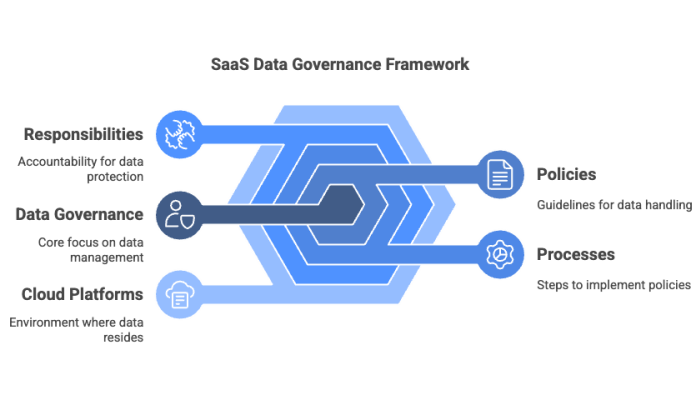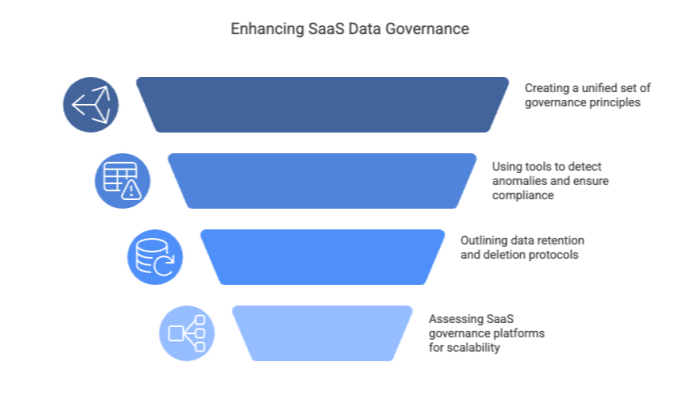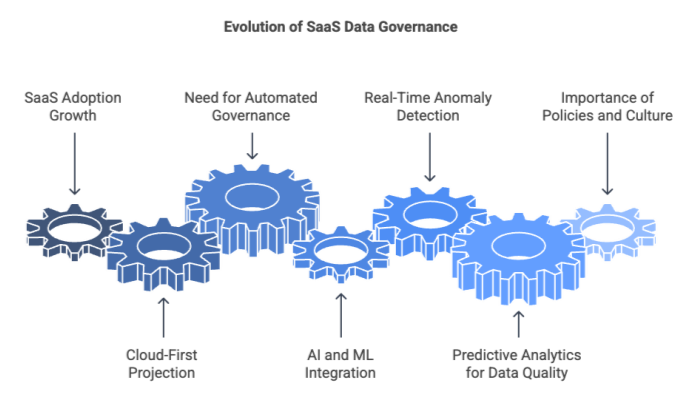

Monday, April 21, 2025
Kim Jamerson
Software‑as‑a‑service (SaaS) solutions offer businesses a fast track to operational efficiency across the organization–from cloud‑based CRMs (sales) and ERPs (finance) to HRMSs (human resources) and project management tools (operations).
However, with every new SaaS platform adopted, another set of company data moves outside the traditional IT perimeter. That shift makes SaaS data governance a critical pillar for risk management, compliance, and business continuity.
This article explores what SaaS data governance really means, why it matters, and best practices to implement a framework that scales.

SaaS data governance is focused on managing the availability, usability, integrity, and security of data stored in SaaS applications. It includes establishing policies, processes, and responsibilities to protect your organization’s data across all cloud platforms.
Unlike on‑premise data governance, where IT typically owns and manages the entire data infrastructure, data governance for SaaS requires a more decentralized, policy‑driven approach. Why? Because SaaS application data resides mainly in the cloud in third‑party environments. That means clear accountability must be defined between internal stakeholders and external vendors.


Establishing an effective strategy for SaaS data governance involves more than IT oversight. Legal, compliance, security, operations, and business teams need to collaborate.
Clear data ownership is the foundation of governance. Every dataset with your SaaS ecosystem should have a defined owner or steward. That is, someone accountable for maintaining the dataset’s accuracy, relevance, and lifecycle management (from creation to deletion).
Without ownership, data quality often quickly deteriorates. According to Experian, “95% of organizations see negative impacts from poor data quality, affecting customer experience, business efficiency and reputation.”
Another central tenant of data governance is to ensure only the right people can view or manipulate sensitive information. Implement role‑based access controls (RBACs), multi‑factor authentication, and single sign‑on security protocols. Additionally, adopt the principle of least privilege across all SaaS tools.
Many breaches stem from misconfigurations in access controls and policies. According to IBM’s 2024 Cost of Data Breach Report, the most common initial attack vector for breaches was stolen/compromised credentials (16%), which also took the longest to identify and contain (~10 months).
Depending on your industry and geographic footprint, SaaS applications must be evaluated for compliance with applicable regulatory mandates, such as the General Data Protection Regulations (GDPR), the California Consumer Privacy Act (CCPA), and the Health Insurance Portability and Accountability Act (HIPAA).
The laws mandate everything from data residency and breach notification protocols to consent tracking and encryption standards, and they apply to both your company and your SaaS providers.
Metadata provides context that makes data usable—for example, definitions, formats, relationships, and ownership. Without consistent metadata across platforms, teams struggle to interpret and trust the data. A solid data governance framework will ensure metadata is standardized, documented, and accessible.


Strong SaaS data governance requires proactive planning, clear policies, and continuous oversight. Here are four best practices to help your organization develop and evolve its data governance and SaaS capabilities.
Begin by creating a unified set of governance principles that apply to all SaaS applications, regardless of vendor or department. This policy should include:
Centralizing governance rules versus leaving those decisions up to each department creates consistency and reduces the risks associated with shadow IT.
Adopt automated tools that regularly scan your SaaS environment for anomalies, such as inactive user accounts, suspicious activity, or sensitive data housed in unsecured fields. In addition to continuous monitoring, regular audits of policies and processes will help catch issues before they become security incidents or compliance violations.
Not all data needs to be captured or kept forever. Data lifecycle policies outline when information should be archived, anonymized, or deleted. These protocols help reduce storage costs and privacy risks.
For example, GDPR mandates that personal data should not be captured or stored longer than necessary for legitimate purposes. Failure to comply can result in hefty fines. For example, Luxembourg’s privacy regulator slapped Amazon with an $812 million fine for violations stemming from how the company used cookies to capture, store, and use customer information.
Define lifecycle stages and retention policies for different data types (e.g., customer, employee, financial) and automate enforcement within your SaaS tools wherever possible to avoid potential penalties.
As your SaaS portfolio grows, manually managing data governance can become unsustainable quickly. That’s where SaaS data governance platforms come in with features such as:
Some popular SaaS data governance platforms include Collibra and Alation. When evaluating vendors, prioritize ease of integration, scalability, and support for your compliance needs based on your size, industry, and tech stack.


The pace of SaaS adoption isn’t slowing down. According to Gartner, more than 85% of organizations are projected to be “cloud‑first” in 2025, with 95% of new digital workloads expected to be deployed on cloud‑native platforms.
That shift raises the stakes for SaaS data governance. It increases the need for businesses to evolve their governance models to become more automated and intelligence‑driven, incorporating AI and machine learning technologies to transform how governance is handled.
Advancements like real‑time anomaly detection and predictive analytics for data quality issues can scale data governance without dramatically increasing overhead. But technology isn’t a silver bullet. Clear policies, defined ownership/stewardship, and a culture of accountability are essential to success.


A modern approach to data governance for SaaS solutions gives organizations the clarity and control they need to grow without sacrificing agility or security. It’s about empowering your teams with trusted data to improve decision‑making and unlock the full value of your software investments.
Whether you build an in‑house governance framework or adopt a purpose‑built SaaS data governance platform, taking a structured approach now will save you from compliance headaches and data chaos later.
